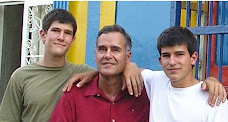 Campesinos from all over the area set up tables displaying their seeds. So did these girls from the school in Monte Carmelo.
Campesinos from all over the area set up tables displaying their seeds. So did these girls from the school in Monte Carmelo.
The third annual “Dia de la Semilla Campesina” was celebrated on October 29th in Monte Carmelo. The whole town was involved in preparing for the hundreds of visitors, some of them coming from as far away as Maracay, Trujillo, and Caracas.

Events began at 9 a.m. with a mass celebrated by Father Mario, one of the members of La Alianza Cooperative. He praised the earth and the seeds and emphasized the need for harmonious relationships among humankind, plants, animals, and God. At this particular moment, Mario said, the primary enemy of these relationships is money and global capitalism, especially never-ending drive to accumulate capital by multinational corporations that are attacking the integrity of seeds and campesino life with their reckless production and dissemination of newly invented, transgenetic seeds. Children from the local schools offered prayers they had composed, some asking God to forgive us for the damage we had done to the Earth.
Father Mario, who is usually seen working in the fields above the village, has an easy-going style on the occasional Sundays or holidays when he appears in church. He asks questions of the audience and they feel free to stand and offer social commentary, scientific speculation, and general opinions and anecdotes.
Declaration of the Campesina Seed
We, the campesino seeds, gathered in assembly with
the campesinos and campesinas of Monte Carmelo, declare:
That we are the nutritious hope of our people.
That for centuries we have filled stomachs,
pockets, marusas, bags, and granaries.
That we are part of the Venezuelan people,
because we are all togetherat breakfast, lunch, merienda and dinner.
That, besides being nourishment, we are also medicine
and happiness forthe campesinos and campesinas.
That we create and give life when our love merges
with the love of the humble and unassuming people of the fields;
and that we love being grownas we were grown in the past,
without being mistreated.
That, despite the persecution and mistreatment we have received
from other seeds that are more powerful than us,
we are still curled up safely in Monte Carmelo.
That, with courage and bravery we have resisted the harshness
of herbicides and insecticides that have been spread over us.
That we are born from the womb of Mother Earth
and we cry with her because she’s damaged and unloved.
That we love being caressed by fresh water once we are sowed.
That we are friends of the insects, birds and microorganisms that
sing us songs of love and fertility
in the voice of patriotism and national identity.
For these reasons and many more we proclaim to the world:
That we need to unite with all the seeds in the world,
especially those in Latin-America and the Caribbean.
That all of us seeds should organize ourselves in cooperatives
in order to defend our existence.
That those who aren’t familiar with us should get to know us,
so that they can help us reproduce andsupport us in our struggles for justice.
That the creation of indigenous Seed Banks
should be promoted in every Venezuelan village.
That love for us should be promoted in schools, high-schools, universities
and all other centers of education.
That girls and boys should play with us when they are washing us for dinner.
That, as nourishment, we should never be missing
at the tables of any Venezuelans.
That the campesino seeds should be able to enjoy life
with men, women, boys, girls, and young people
in an environment free of contamination
by toxic agricultural substances and industrial waste;
and to avoid, by any means necessary, being displaced
by imported and transgenetic seeds;
and to be ourselves, with our own flavor, color and aroma.
The seeds of Monte Carmelo, together with their hardworking friends,
the faithful inhabitants of this village;
declare that this day, October 29th,
is the Day of the Campesino Seed
so that it will be celebrated
every year on this date in all of Venezuela,
with the respect and appropriate honors that signify
that this is a memorable a day for the Venezuelan people.
Finally, the seeds present in this assembly
agree by consensus and unanimously
to spread copies of this declaration throughout the whole world.
Signed, sealed, and delivered in Monte Carmelo,
on the 29th day of the month of October, 2005.
On behalf of the seeds named above,
The Paspasa Seed (Gaudy Maria Garcia, 2005)

 Campesinos from all over the area set up tables displaying their seeds. So did these girls from the school in Monte Carmelo.
Campesinos from all over the area set up tables displaying their seeds. So did these girls from the school in Monte Carmelo. The third annual “Dia de la Semilla Campesina” was celebrated on October 29th in Monte Carmelo. The whole town was involved in preparing for the hundreds of visitors, some of them coming from as far away as Maracay, Trujillo, and Caracas.
The third annual “Dia de la Semilla Campesina” was celebrated on October 29th in Monte Carmelo. The whole town was involved in preparing for the hundreds of visitors, some of them coming from as far away as Maracay, Trujillo, and Caracas.




























